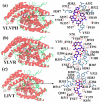Antihypertensive and Angiotensin-I-Converting Enzyme (ACE)-Inhibitory Peptides from Fish as Potential Cardioprotective Compounds
- PMID: 31671730
- PMCID: PMC6891548
- DOI: 10.3390/md17110613
Antihypertensive and Angiotensin-I-Converting Enzyme (ACE)-Inhibitory Peptides from Fish as Potential Cardioprotective Compounds
Abstract
The term metabolic/cardiometabolic/insulin resistance syndrome could generally be defined as the co-occurrence of several risk factors inclusive of systemic arterial hypertension. Not only that organizations, such as the world health organization (WHO) have identified high blood pressure as one of the main risk factors of the cardiometabolic syndrome, but there is also a link between the occurrence of insulin resistance/impaired glucose tolerance and hypertension that would consequently lead to type-2 diabetes (T2D). Hypertension is medicated by various classes of synthetic drugs; however, severe or mild adverse effects have been repeatedly reported. To avoid and reduce these adverse effects, natural alternatives, such as bioactive peptides derived from different sources have drawn the attention of researchers. Among all types of biologically active peptides inclusive of marine-derived ones, this paper's focus would solely be on fish and fishery by-processes' extracted peptides and products. Isolation and fractionation processes of these products alongside their structural, compositional and digestion stability characteristics have likewise been briefly discussed to better address the structure-activity relationship, expanding the reader's knowledge on research and discovery trend of fish antihypertensive biopeptides. Furthermore, drug-likeness of selected biopeptides was predicted by Lipinski's rules to differentiate a drug-like biopeptide from nondrug-like one.
Keywords: ACE-inhibitory peptide; antihypertensive; cardiometabolic-syndrome; fish; high blood pressure; hydrolysate; hypertension.
Conflict of interest statement
The authors declare no conflict of interest.
Figures



References
-
- Grundy S.M., Cleeman J.I., Daniels S.R., Donato K.A., Eckel R.H., Franklin B.A., Gordon D.J., Krauss R.M., Savage P.J., Smith S.C. Diagnosis and management of the metabolic syndrome: An American Heart Association/National Heart, Lung, and Blood Institute scientific statement. Circulation. 2005;112:2735–2752. doi: 10.1161/CIRCULATIONAHA.105.169404. - DOI - PubMed
-
- Kelli H.M., Kassas I., Lattouf O.M. Cardio metabolic syndrome: A global epidemic. J. Diabetes Metab. 2015;6:2. doi: 10.4172/2155-6156.1000513. - DOI
Publication types
MeSH terms
Substances
LinkOut - more resources
Full Text Sources
Other Literature Sources
Medical
Miscellaneous

